Translator’s Preface
In the crypto space, especially in the recent context of large-scale surveillance and increasingly stringent regulation, privacy and security issues have become increasingly prominent. The recent arrest of TG (Telegram) founder Pavel Durov has attracted widespread attention, revealing the complex relationship between privacy and surveillance. This incident not only highlights the vulnerability of users in the face of regulatory pressure, but also emphasizes the importance of anonymity as an adaptive mechanism to combat surveillance. As the positive feedback loop between anonymity and surveillance continues to intensify, how to find a balance between protecting personal privacy and responding to regulatory challenges has become a key issue that needs to be addressed.
This reminds us of Lunarpunk, which was first introduced by Rachel-Rose O’Leary in a 2022 article, this week’s translation, Lunarpunk and the Dark Side of the Cycle. The dark side of the moon is the soil in which moon punk grows, but solar punk rarely touches it. Moon punk and solar punk are also exquisite pairs: openness and transparency and privacy, bull market and bear market, daylight and night. In the battle with the night, what moon punk needs first is privacy.
For more discussion of these two cultures, please refer to:
https://www.coindesk.com/opinion/2022/09/20/what-are-solarpunk-and-lunarpunk-anyway/
Main content
《Moon Punk and the Dark Side of the Cycle》
Science fiction is an exercise in speculation. By speculating on possible futures, science fiction expands the space of possibilities. Cryptocurrency is an extreme form of science fiction because it not only provides a vision of the future, but also the tools to achieve this future.
Currently, cryptocurrency is driven by a sci-fi idea called "Solarpunk". Evolved from Cyberpunk, Solarpunk is a utopian vision of the future characterized by its optimistic attitude. For Solarpunk, the future is bright. Solarpunk abandons the dystopian shadows in Cyberpunk and illuminates the world beyond the horizon of chaos.
In Ethereum, Solarpunk hackers are creating "transparent infrastructure" (https://www.coindesk.com/tech/2021/09/02/are-daos-socialist/) to fund public goods. The imagination is simple: decentralization and transparency will lead the world to a more fair and just future. Web3 is creating a new path for mankind, and old institutions will inevitably follow this trend.
Solarpunk is the sober heart of the crypto world. It is bright, confident, and future-oriented. However, the opposite of Solarpunk belief is the skepticism of Lunarpunk. Moonpunk is the Shadow-self of Solarpunk. It is the unconscious part of this cycle. While "Solarpunk joins the DAO" (Dylan-Ennis: https://x.com/post_polar_), Moonpunk is preparing for war and building privacy-enhancing tools to protect their community.
Translator's Note: Shadow-self is a psychological concept derived from Carl Jung's theory, referring to the repressed or unrecognized parts of an individual's mind. These parts often include emotions, desires, or traits that the individual is unwilling to face, which may be negative or considered unacceptable by society.
Moonpunk was originally a subset of Solarpunk. It has always preferred cryptography over the plaintext paradigm provided by Ethereum. Over time, the tensions brought about by Solarpunk tendencies have increased. Moonpunks are forced to break away from the remnants of solarpunk and establish their own position.

In the moonpunk imagination, the conflict between the crypto world and the existing power structure is essentially doomed. Regulation drives the crypto world underground, and anonymity grows. In the interstellar darkness, new radicalized crypto factions create a new kind of democratic society.
This conflict is repressed in the solarpunk psyche. The lunar cycle is rejected as a nightmare for the bear market. Its fundamental conflict: state bans on the crypto space - known as FUD because it induces fear, making people rush to grab their money and run.
Translator's Note:
FUD: is the abbreviation of "Fear, Uncertainty and Doubt".
As the supercycle diverges, the depression of solarpunk continues to grow. Solarpunk's optimism has been equated with the bull market cycle, while pessimism has been linked to the bear market. Moonpunk provides a perspective beyond this simple fluctuation. It is a moment of insight between market cycles, a glitch in the hologram, and the source code shines through it.
Solarpunk's Fragility
Fragile things break when shaken. Antifragile things become stronger after absorbing shocks.
The fate of antifragility follows a convex curve, while fragility is concave.
Consider the following. The core innovation of cryptocurrencies is two-sided - it increases user power while diffusing its attack surface (in equal proportions). User empowerment is negatively correlated with fragility; the more powerful the user base, the higher the antifragility of the network.
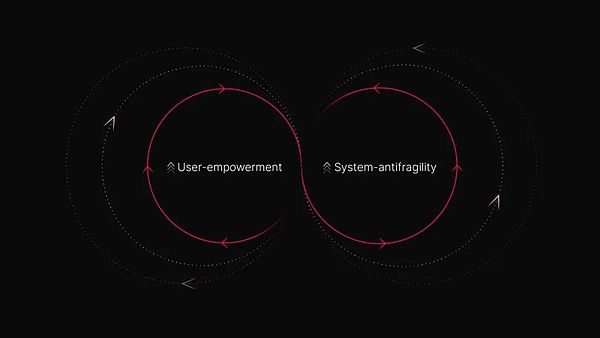
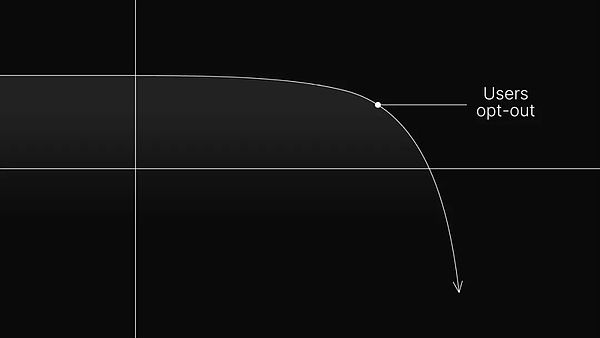
The solarpunk mentality is inherently optimistic. Transparency in solarpunk systems is projected optimism. By building transparent systems, solarpunk conveys the belief that I trust the law will not turn against me. Its insistence on optimism makes it unable to prepare for the worst. This is the core of solarpunk's fragility.
The Choice of Darkness
Taleb's argument for antifragility relies on unknowability. According to Taleb, the future is dark: it cannot be predicted with meaningful certainty. He describes optionality as a “weapon of antifragility” because it is able to use this darkness to one’s advantage. Optionality assumes that your predictions will be wrong most of the time. The cost of being wrong is low, while the reward of being right is relatively generous.
Moonpunk incorporates optionality because it thrives on the worst-case scenario. If Moonpunk’s thesis is wrong, the supercycle will continue. If it is right, crypto will enter its next phase with proper defenses in place. Good defense means stealth: using cryptography to protect a user’s identity and activity. This is the cornerstone of Moonpunk’s convexity.
In the solarpunk future, users flee in the face of persecution. But Moonpunk offers user protection. Participants in the dark web have plausible deniability. Changes in regulation have no effect on them. The only reason a regulatory crackdown causes users to leave the network is if they do so voluntarily.
Crypto’s antifragility only manifests itself when anonymity is combined with persecution. Still, to be truly antifragile, cryptocurrency must do more than survive the regulatory onslaught. It must thrive in the face of attack. Moonpunks believe that through anonymity, escalating conflict only strengthens the crypto world’s power, and that this power grows exponentially with the decline of attackers.
Convexity: A Prophecy
Anonymity first arose as an adaptation to mass surveillance. But its existence also further justifies the act of surveillance. It’s a positive feedback loop that means anonymity and surveillance are destined to escalate.
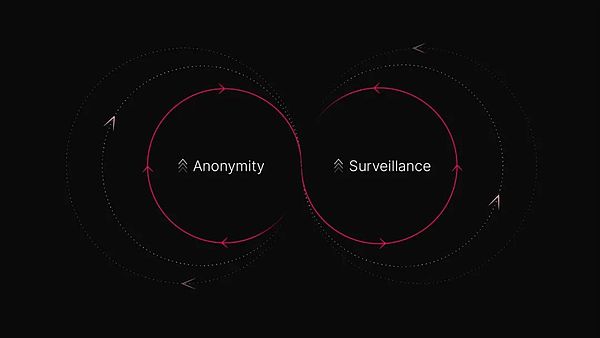
In a paradigm defined by surveillance, cryptocurrency’s anonymity makes it an outlier. After running long enough, this cycle will trigger the next stage in Moonpunk Convexity - what I call the Regulatory Trap. In this stage, attackers use the increase in anonymity as an excuse to use their full power against the crypto world.
However, by striking at crypto, the hostile forces only further justify it. The usefulness of the crypto space is related to the extent of the strike: each strike disproportionately expands it. Antifragility.
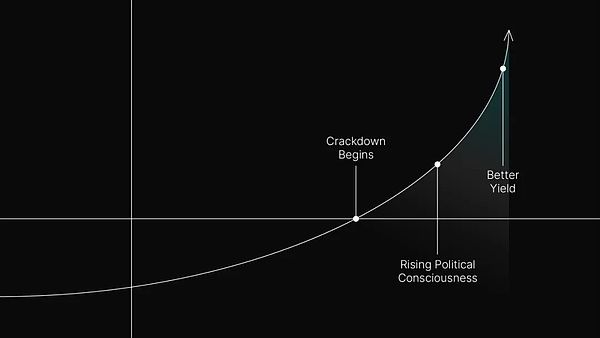
The Regulatory Trap forces cryptocurrencies underground. This has multiple consequences:
1. Rising Political Consciousness
Anonymity is a catalyst for political consciousness in the crypto world. After the regulatory crackdown, the distinction between the crypto and fiat worlds became more pronounced. Only by establishing this separation can cryptocurrencies build a new world that reflects its values.
2. The Center is Eliminated
Crypto at war is hardened crypto. Those factions that prefer to compromise with hostile forces will be integrated into the power structure or eliminated. This is a kind of extermination of projects that compromise morally. This will empower the crypto world over time by clarifying the most ideological elements within it.
3. Better Yields
The crypto world is littered with the corpses of bad incentive designs. No corpse of design is denser and more centralized than the old privacy coins. They are a masterclass in poor monetary allocation and inflationary policies. The flip side is that the true value of privacy projects may be much higher.
The new wave of privacy coders are skilled in financial engineering. Therefore, the final stage of Moonpunk Convexity is economic. Only those who voluntarily reject the fiat currency paradigm can enter the moon settlements. Anonymous alien worlds offer a revolutionary yield to those with a firm ideology to cross no man's land.
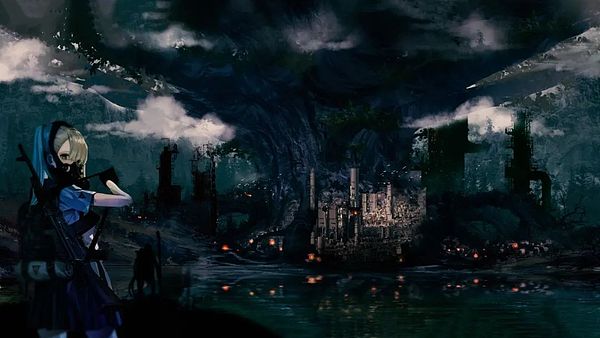
The Cycle of the Moon
The sun is both a symbol of nature and a symbol of tyranny. Through its insistence on transparency and identity, solarpunk inherits the dual characteristics of its core symbol. Solarpunk systems are desert landscapes, where users are at risk and exposed.
Moonpunk is more like a forest. The dense cover of encryption protects the tribe and provides shelter to the persecuted. The woodland trees provide a critical line of defense. The lunar landscape is dark and full of life at the same time.
Moon technology is owned by the people themselves, run by the people themselves, and serves their freedom. The moon settlement is a sanctuary where difference is cultivated and protected. The Moon Cycle defends democratic technology against authoritarian technology, freedom against surveillance, and diversity against monoculture.
Moonpunks believe that freedom can only be found outside the logic of domination. This means that Moon Society must completely break away from the current paradigm. Therefore, the future of Moonpunk is born out of the conflict that Solarpunk seeks to avoid.
Solarpunk's repression is its greatest weakness. If Solarpunk has integrated into the oppression it hopes to escape, then it cannot build the vision it projects. By preferring transparency in its systems, Solarpunk is tragically engineering its destiny. Surveillance - the mechanism of Authoritarianism - is tied to Solarpunk's fate.
For Solarpunk to succeed, it must integrate the Moonpunk unconscious. Solarpunk's only hope is to go dark.
 JinseFinance
JinseFinance
 JinseFinance
JinseFinance Coinlive
Coinlive  Others
Others Others
Others Coindesk
Coindesk Bitcoinist
Bitcoinist Cointelegraph
Cointelegraph Bitcoinist
Bitcoinist Cointelegraph
Cointelegraph Cointelegraph
Cointelegraph